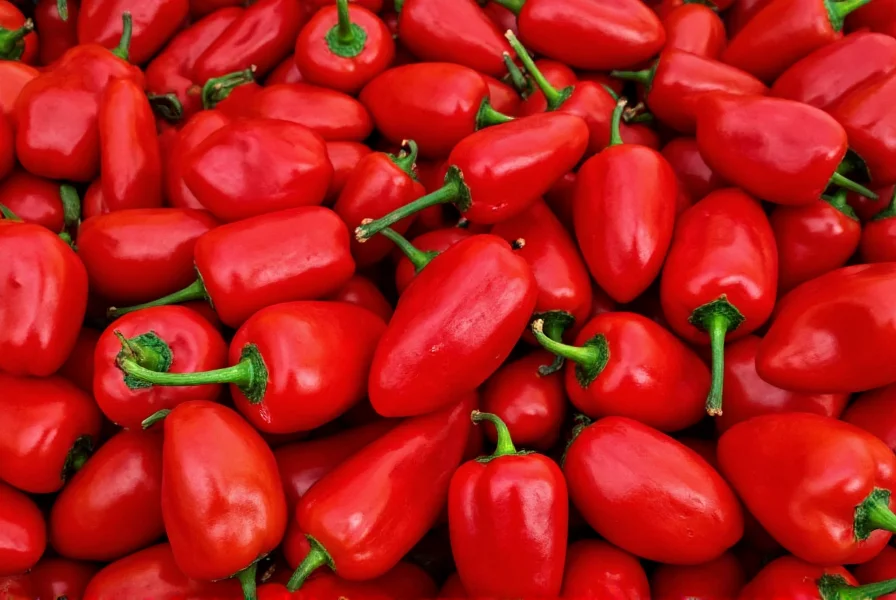Red peppers encompass numerous varieties across multiple Capsicum species, with common names including bell peppers (when ripe), cayenne, habanero, tabasco, and cherry peppers. Scientific classification reveals five primary species: Capsicum annuum (most common culinary peppers), C. chinense (extremely hot varieties), C. frutescens (tabasco-type peppers), C. baccatum, and C. pubescens. Color indicates ripeness rather than variety—most green peppers turn red when fully mature.
Understanding red pepper names requires distinguishing between botanical classifications, maturity stages, and regional naming conventions. While "red pepper" commonly refers to ripe bell peppers in grocery stores, the term technically applies to any mature chili pepper that develops red pigmentation. This comprehensive guide explores the taxonomy, nomenclature, and characteristics of red-hued pepper varieties essential for culinary applications and gardening.
Botanical Classification of Red Peppers
Pepper taxonomy follows the Capsicum genus, with five domesticated species producing red-fruited varieties. The color transformation from green to red occurs as chlorophyll breaks down and carotenoids develop during ripening. This biological process affects flavor profiles, with red peppers typically sweeter and more complex than their immature counterparts.
Major Capsicum Species with Red Varieties
| Species | Common Red Varieties | Scoville Range | Distinctive Characteristics |
|---|---|---|---|
| Capsicum annuum | Bell, Cayenne, Poblano (Ancho when dried) | 0-50,000 SHU | Largest species variety; includes sweet and hot types |
| Capsicum chinense | Habanero, Scotch Bonnet, Trinidad Moruga | 100,000-2,000,000 SHU | Intense fruity flavor; lantern-shaped varieties |
| Capsicum frutescens | Tabasco, Malagueta | 30,000-50,000 SHU | Intermediate heat; grows upright on bushy plants |
| Capsicum baccatum | Aji Panca, Aji Amarillo (when red) | 30,000-50,000 SHU | Distinct vinegar-like aroma; elongated pods |
Understanding Red Pepper Nomenclature
Pepper naming conventions create frequent confusion among consumers and cooks. The term "red pepper" varies significantly by region and context:
- Color-based naming: In North America, "red pepper" typically means ripe bell peppers, while in the UK it often refers to chili peppers generally
- Maturity indicators: Many green peppers (jalapeños, poblanos) turn red when fully ripe, changing both color and flavor profile
- Drying terminology: Poblanos become Anchos when dried, while Guajillos refer to dried Mirasol peppers

Detailed Red Pepper Varieties Guide
Capsicum annuum Red Varieties
Bell Peppers (Capsicum annuum): When fully ripened, these sweet peppers develop from green to red, containing three times more vitamin C than citrus fruits. The red bell pepper varieties names include California Wonder, Red Knight, and Sweet Red.
Cayenne Peppers (Capsicum annuum): These slender, tapered peppers measure 30,000-50,000 SHU. Known as guinea peppers in some regions, they're essential for cayenne powder production. Different red cayenne pepper types include Long Red Slim, Thai Hot, and Hungarian Wax (when mature).
Capsicum chinense Red Varieties
Habanero Peppers: Among the hottest red pepper names, habaneros feature distinctive lantern shapes and floral notes. Red habanero varieties include the standard Red Habanero (200,000-350,000 SHU) and the slightly milder Red Savina (formerly Guinness record holder).
Scotch Bonnet: Nearly identical to habaneros but with a distinctive bonnet shape, these Caribbean staples range from 100,000-350,000 SHU. The red scotch bonnet pepper varieties are essential for jerk seasoning and tropical hot sauces.
Lesser-Known Red Pepper Types
Tabasco Peppers (Capsicum frutescens): These small, tapered peppers (30,000-50,000 SHU) give Tabasco sauce its distinctive flavor. The tabasco pepper varieties names include the standard Tabasco and the slightly milder Tabasco Tiger Stripe.
Aji Panca (Capsicum baccatum): This Peruvian specialty offers mild heat (1,000-5,000 SHU) with rich berry notes. Among red aji pepper varieties, Aji Panca stands out for its deep burgundy color and smoky-sweet profile.
Practical Identification Tips
When identifying red pepper varieties, consider these characteristics:
- Shape and size: Bell peppers are blocky while cayennes are slender
- Surface texture: Habaneros have distinctive puckering; bell peppers are smooth
- Stem attachment: Capsicum chinense varieties often have stems that grow upward
- Aroma: C. chinense varieties emit distinctive fruity notes when cut
For gardeners seeking specific red pepper varieties names, seed catalogs typically list both common and botanical names. Understanding these distinctions helps select appropriate varieties for culinary applications—sweet red bells for salads, medium-heat cayennes for sauces, or fiery habaneros for extreme heat enthusiasts.
Frequently Asked Questions
What's the difference between red bell peppers and other red chili peppers?
Red bell peppers belong to the sweet pepper category (Capsicum annuum) with zero Scoville heat units, while most other red peppers are chili varieties ranging from mild to extremely hot. The red color in bell peppers indicates full ripeness of what was originally a green pepper, whereas many chili varieties naturally mature to red.
Why do some green peppers turn red when ripe?
Peppers change color during ripening as chlorophyll breaks down and carotenoid pigments develop. This biological process occurs in most Capsicum varieties, transforming green immature peppers to yellow, orange, and finally red when fully ripe. The color change correlates with increased sugar content and flavor complexity.
Are all red peppers spicy?
No, red bell peppers have no heat (0 SHU), while other red peppers range from mild (poblanos at 1,000-2,000 SHU) to extremely hot (red habaneros at 100,000-350,000 SHU). Color indicates ripeness rather than heat level—many sweet pepper varieties turn red when mature.
What are the most common red pepper varieties used in cooking?
The most widely used red pepper varieties include red bell peppers (sweet applications), cayenne peppers (spicy dishes and powders), red jalapeños (salsas and pickling), and red habaneros (Caribbean and hot sauces). Regional specialties include Aji Panca in Peruvian cuisine and Gochugaru (Korean red pepper flakes) in Korean cooking.
How can I identify different types of red peppers?
Identify red peppers by examining shape (blocky bells vs. tapered cayennes), surface texture (smooth bells vs. puckered habaneros), stem orientation (upright in C. chinense), and aroma (fruity notes in habaneros). For precise identification, consult botanical references noting that Capsicum annuum varieties typically have white flowers while C. chinense varieties have greenish flowers.











 浙公网安备
33010002000092号
浙公网安备
33010002000092号 浙B2-20120091-4
浙B2-20120091-4